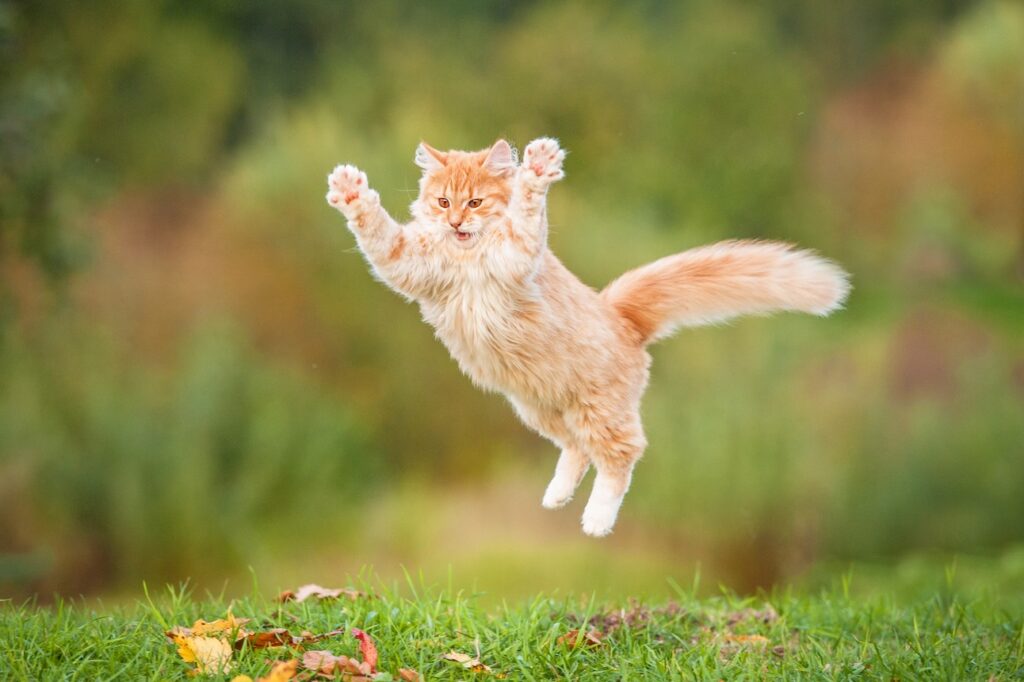How High Can Cats Jump, And How Do They Do It?

Photo by Adobe/Rita Kochmarjova
If you’ve ever watched your cat leap effortlessly onto a windowsill or scale a bookshelf in seconds, you’ve likely wondered—why do cats jump so much?
Jumping isn’t just a fun pastime for cats; it’s an essential part of how they explore, stay safe, and stay active. From navigating their environment to satisfying their hunting instincts, cats rely on their powerful legs and sharp senses to take them to new heights—literally.
Key Takeaways
- Cats jump to explore their surroundings, hunt, and play; these behaviors are rooted in their natural instincts.
- Most cats can jump up to 8 or 9 feet vertically thanks to their powerful hindlimbs and flexible spine.
- Factors like age, breed, and health conditions affect how high a cat can jump.
- Providing safe spaces to encourage your cat’s jumping is an important part of their care.
Why Do Cats Jump?
“Cats jump as a way to navigate their environment,” says Joey Lusvardi, CCBC, owner of Class Acts Cats in Minneapolis. “Oftentimes, they’ll jump to explore or see if they can gather more information about their surroundings.”
Some common reasons cats jump include:
- Seeking tall vantage points: Jumping up to high places is a behavior derived from their predator-prey instincts. Being high up allows a cat to watch for prey while also keeping an eye out for predators.
- Hunting: Pouncing on prey is an important part of the hunt.
- Playing: Jumping for wand toys or toy mice simulates hunting and provides much-needed physical exercise and mental stimulation.
Recommended Products
How High Can Cats Jump?

Photo by Chewy
Cats can jump about five to six times their body length in a single vertical leap, says Sarah Cortright, DVM. The average housecat measures about 18 inches long. So, most cats can jump 8 to 9 feet.
If humans had the same jumping ability, a 6-foot person would be able to make a 36-foot leap—that’s the height of a telephone pole!
How Can Cats Jump So High?
If you’ve watched a cat effortlessly spring from the ground to a high perch or stick a perfect landing, you know that cats are basically furry acrobats.
Dr. Cortright says a cat’s impressive jumping ability comes from having powerful hindlimb muscles, a flexible spine, and a strong sense of balance.
Before a cat jumps, you’ll often see them crouch down—essentially loading their spring-like hind legs with energy for the leap.
After launching, their flexible spine makes it possible to adjust in midair. If you pay close attention, you’ll often see a cat’s tail move as they land, acting as a counterbalance to keep them steady on their feet.
Can All Cats Jump High?
Just like people have different athletic abilities, not all cats have the same jumping prowess. Some of the most common factors that impact cat jumping include:
- Age: Senior cats (those 7 years old or older) may be less motivated to jump up to a higher vantage point, either because of reduced muscle mass, discomfort, or other health conditions.
- Health and body condition: Dr. Cortright says cats with arthritis, muscle weakness, or obesity may experience reduced mobility, which limits their jumping.
- Breed: A cat’s physical attributes are related to breed. Some small cat breeds, especially those with proportionally shorter legs (like the Munchkin cat), may have a more limited vertical jump than athletic cats with longer bodies and legs (like the Abyssinian).
How To Help Your Cat Jump Safely
Sometimes, cats can jump up into danger: onto countertops with toxic food, onto a hot stove, or onto a shelf that can’t quite hold all their weight.
You can discourage your cat from jumping onto risky spaces by offering safe and sturdy alternatives. Lusvardi says this works better than trying to use deterrents like tin foil or spray bottles, which can be stressful for your cat.
“It’s better to focus on removing the motivation for the cat to [jump onto unsafe spaces] or offering an alternative option that meets their need to climb nearby,” he adds.
Anchor a tall, well-built cat tree to your wall or mount cat shelves to offer a safe place to perch. These features can also help scaredy cats gain more confidence in jumping and help your kitty exercise, too.
Recommended Products
“Cats that are used to leaping onto shelves or cat trees build skill and muscle over time,” Dr. Cortright says.
Preventing boredom or attention-seeking is another way to reduce jumping. Playing with your cat a few times every day and offering interactive toys and puzzle feeders is a good way to keep your cat occupied and provide mental enrichment.
Recommended Products
FAQs About Cats Jumping
What is the maximum height a cat can jump?
Most cats can jump 8 to 9 feet high at most.
How high does a fence need to be to keep cats in?
Because many cats can jump 6 feet or more in a single leap, Lusvardi says a fence or pet gate should be at least 8 feet tall.
Can cats hurt themselves when jumping?
Yes, cats can hurt themselves when jumping. Dr. Cortright says sprains, fractures, and soft tissue injuries can happen, especially when a cat jumps from a great height, lands on a slippery surface, or misjudges a distance.
Do cats always land on their feet?
It’s a myth that cats always land on their feet. While cats have what is known as a “righting reflex,” which allows them to twist their body and land with their paws on the ground, it doesn’t always happen.
“They have to have time to flip over in the air,” Lusvardi says. “Usually, a fall of at least 3 feet is necessary for it to happen.”














